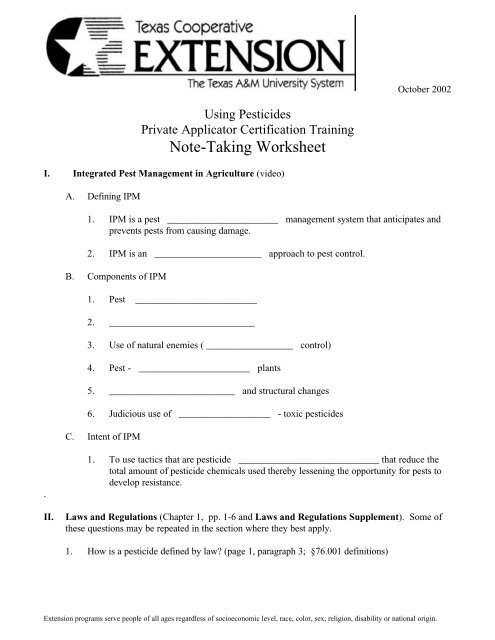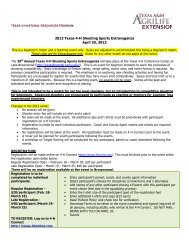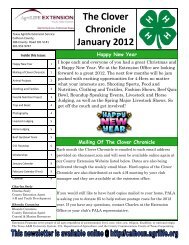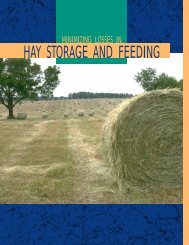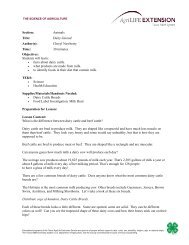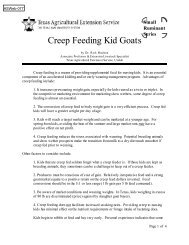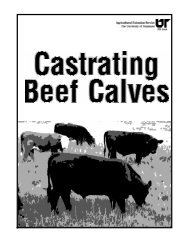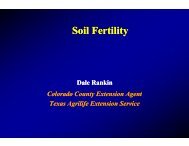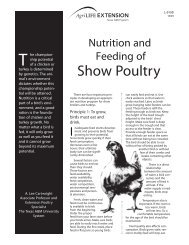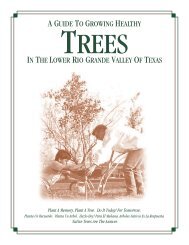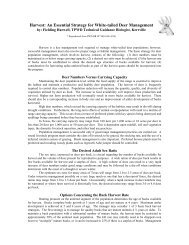Private Applicator Note Taking worksheet - Sutton County
Private Applicator Note Taking worksheet - Sutton County
Private Applicator Note Taking worksheet - Sutton County
Create successful ePaper yourself
Turn your PDF publications into a flip-book with our unique Google optimized e-Paper software.
October 2002Using Pesticides<strong>Private</strong> <strong>Applicator</strong> Certification Training<strong>Note</strong>-<strong>Taking</strong> WorksheetI. Integrated Pest Management in Agriculture (video)A. Defining IPM1. IPM is a pest _______________________ management system that anticipates andprevents pests from causing damage.2. IPM is an ______________________ approach to pest control.B. Components of IPM1. Pest _________________________2. ______________________________3. Use of natural enemies ( __________________ control)4. Pest - _______________________ plants5. __________________________ and structural changes6. Judicious use of ___________________ - toxic pesticidesC. Intent of IPM.II.1. To use tactics that are pesticide _____________________________ that reduce thetotal amount of pesticide chemicals used thereby lessening the opportunity for pests todevelop resistance.Laws and Regulations (Chapter 1, pp. 1-6 and Laws and Regulations Supplement). Some ofthese questions may be repeated in the section where they best apply.1. How is a pesticide defined by law? (page 1, paragraph 3; §76.001 definitions)Extension programs serve people of all ages regardless of socioeconomic level, race, color, sex, religion, disability or national origin.
The Texas A&M University System, U.S. Department of Agriculture, and the <strong>County</strong> Commissioners Courts of Texas Cooperating2
2. Which state and federal agencies register pesticides? (page 2, paragraph 1; §76.001definitions)3. What is the federal law that regulates the sale and use of pesticides? (page 2, paragraph 2;§76.001 definitions)4. What is a state-limited-use pesticide? (page 2, paragraph 3; §76.003)5. As defined by law, what is a private pesticide applicator? (page 2, paragraph 4; A2, page 79;§76.112)6. When supervising pesticide use, must the private applicator be physically present? Is theapplicator responsible for actions of the supervised workers? (page 3, paragraph 2; §7.31)7. Who is responsible for assuring that any person working under the licensee's directsupervision is knowledgeable of the label requirements and rules and regulations governingthe use of the particular pesticide being used by the individual? (page 3, paragraph 2; §7.31)8. What practical knowledge and skills should a private applicator have? (page 3, items listed1-5)9. What is the significance of pesticide label directions with regard to the law? (page 3,paragraph 5; §7.71)10. What types of laws are violated when the applicator uses pesticides inconsistent with labeldirections? Examples: Is it ever legal to use more than the labeled rate? Is it ever legal toallow the pesticide to DRIFT off of the target site? (page 3, paragraph 5; §7.71)11. What role do Texas counties have in regulating pesticides? (page 4, paragraph 1; §7.50)3
12. What is a spray permit? (page 4, paragraph 1; §7.50)13. When does a spray permit expire? (§7.50)14. List some applications that would require a spray permit and some that would not require aspray permit and some that are prohibited from having a spray permit. (§7.50)15. What Continuing Education Units (CEUs) are required to renew the private applicator’slicense? (page 5, paragraph 3; §7.24)16. What late fees are added to the renewal fee if a private applicator does not renew the licenseby February 28 th ? (page 5, paragraph 5; §7.25)17. If an applicator fails to inform TDA of a change in mailing address, what can happen to thelicense? (§7.20)18. When can a person request prior notification? (§7.37)19. Name an excepted method of giving prior notification of a scheduled application to a neighborwho has requested prior notification. (§7.37)20. How long are licensed pesticide applicators required to keep records? What types ofpesticides are required to be included in these records? (§7.33)21. Explain what is needed when the regulations require that the total volume of spray mix, dust,granules, or other materials applied per unit be recorded. (§7.33) Give an example of what ismeant here.22. List locations that are covered by WPS and others that are exempt. (see Laws andRegulations Supplement WPS - 40 CFR, Subpart A, §170.1).4
23. Compare the terms “Agricultural Employer” and “Handler Employer” as used in the WPS.(see Laws and Regulations Supplement WPS - 40 CFR, Subpart A, §170.3).24. What is an agricultural employer? (see Laws and Regulations Supplement WPS - 40 CFR,Subpart A, §170.3).25. How often is a supervisor required to monitor a handler who is using a highly toxic pesticidemarked with a skull and cross bones and how can they be monitored? (see Laws andRegulations Supplement WPS - 40 CFR, Subpart C, §170.210).26. What items are necessary at the decontamination site(s) and who is responsible for providingthese items? (see Laws and Regulations Supplement WPS - 40 CFR, Subpart C,§170.250).Some of the above questions may be repeated in a later section due to specific subject matter.III. How to Read Pesticide Labels (video, Labels and Labeling, Chapter 2, pp. 7-12)1. Look for the ________________ name on the front of the label. (page 7, paragraph 2)2. ____________________ ingredients are the ones that kill or control the pests. (page 7,paragraph 3)3. ___________________ words tell you how poisonous the pesticide is. (page 8-9, paragraph3 & 1-4)CAUTION:WARNING :least poisonous pesticides - low toxicitymore poisonous or irritating - moderately toxic___________: very poisonous or irritating; MAY also have skull and crossbones -very toxic5
4. When handling pesticides with the DANGER signal word, someone should check on you_______________ every hours . (from video and see WPS - 40 CFR §170.210)5. The _________________________ statements section tells you which parts of your bodyneed special protection and what kind of personal protective equipment to wear. (page 9-10,paragraph 7 & 1-2)6. The ____________________ hazards section tells you if you must take extra care toprotect bees and wildlife or to keep the pesticide out of groundwater and surface water.(page 10, paragraph 3)7. A ________________________________________ is classified as restricted use by EPAbecause it may, without additional regulatory restrictions, cause unreasonable adverse effectsto the environment or to human health (including injury to the applicator). Labels say for saleto and for use by certified applicators or persons under their direct supervision and only foruses covered by the Licensed <strong>Applicator</strong>’s license. (page 10, paragraph 4)8. The ______________________ for use section lists information on mixing, loading andapplication. (page 10, paragraph 5)9. All agricultural pesticides have a restricted __________ interval (REI). The REI is the timeimmediately after a pesticide application when entry into the treated area is limited. (page 11,paragraph 1-2; WPS - 40 CFR, Subpart A, §170.3)10. The _________________ interval is the number of days between when the pesticide isapplied and when the crop is harvested. (page 11, paragraph 3)11. Using a little MORE pesticide than the label recommends is ______________ legal since it isa use inconsistent with label directions. (§7.71 - Use Inconsistent with Label Directions)12. The label ______________ allows drift off of the intended spray target. ( §7.71 - UseInconsistent with Label Directions )6
IV. Groundwater (Chapter 3, pp. 13-16)1. What are some consequences of groundwater contamination? (page 14. paragraphs 2 & 3)2. List some routes by which pesticides may reach groundwater. (page 14, paragraphs 4-5)3. What site features contribute to a greater potential for chemical movement through soil?(page 15, paragraph 3)4. What chemical and physical properties contribute to a pesticide's potential for leaching? (page15, paragraph 4)5. What pesticide application practices help minimize the potential for groundwatercontamination? (page 16, paragraph 1)6. List some ways to minimize direct contamination of groundwater. (page 16, paragraph 2)7. How can back-siphoning be prevented? (page 16, paragraph 3 and also page 26, paragraph 3)8. What procedures should be used to clean out pesticide containers? (page 16, paragraph 6)V. Endangered Species Protection (Chapter 4, pp. 17-19)1. What are the benefits of biological diversity? (page 17, paragraphs 1-2; page 18, paragraphs1-3)2. What is an endangered species? (page 18, paragraph 5)3. What responsibility does the Environmental Protection Agency have with regard toendangered species protection? (page 18, paragraph 7)4. How can the label help protect endangered species? (page 18, paragraph 8)5. Name two government agencies that can provide information on endangered species. (page19, paragraphs 2)7
VI. Pesticide Record-Keeping (video; also refer to RULE §7.33 - - - Records of Application)A. The 1990 Farm Bill and subsequent amendments require you to record basic informationabout a pesticide application. The required information includes:1. applicator _____________________ and certification/license number2. the _______________ , day and year of application3. product or brand name and EPA _______________________ number4. total amount applied of ___________________ pesticide5. _________________ , commodity, stored product or site that received the application6. the __________________ of the area treated, in acres, number of trees or othermeasurement7. the location of application (using maps, county field numbers or legal descriptions sothat the exact area can be identified _________________ years later if requested)B. If you make a ________________ application to an area that is less than of an acre over a24-hour period. then you only need to record:1. date of application2. brand or product name3. EPA registration number4. total amount applied5. the location (designated as spot application, followed with short description)C. Greenhouse and ________________________ applications are not considered spotapplication and therefore do NOT qualify for the shorter list of required data.D. Records must be recorded within ___________ days of the application and then kept for___________ years.E. The regs require that the total volume of spray mix, dust, granules, or other materials appliedper unit be recorded - Give an example of what is meant here.8
VII. Personal Protection and Proper Use (video, Chapter 5, Pesticide Safety, pp. 21-24)A. Protecting Yourself from Pesticides1. When handling pesticides, watch out for spills and splashes. Avoid sprays and dustsfrom pesticide applications. Also avoid ___________________ , which are pesticidesthat remain on the plants, soil, water, equipment, clothing or in the air after anapplication.2. Pesticides can poison or injure you if you: swallow or ________________ them, getthem into your eyes or on your ______________________ .3. The most common route for pesticides to enter the body during use is through the________________ .4. <strong>Applicator</strong>s are more likely to receive high levels of skin exposure when they are_________________ and ______________________ .5. Signs and symptoms of organophosphate poisoning include: ________________ ,____________________ , ___________________ , _____________________ ,____________________ , ____________________ , _____________________ ,_____________________ , ___________________ .B. Personal Protective Equipment (PPE)1. Chemical-resistant PPE can be made of a variety of chemical-resistant material,including PVC and ______________________ .2. Gloves that are made of and leather should NOT be worn when handling pesticides.C. Follow these easy rules for wearing PPE correctly:1. Keep pant legs _______________ the top of boots.2. Wear chemical-resistant ______________ that reach at least half-way to the elbow.3. If applying pesticides toward the ground, wear sleeves over the ______________ ofgloves.4. If working above your shoulders, wear sleeves ______________ your gloves. Makesure you choose gloves with cuffs.9
5. Wear _________________ over your regular work clothes to give your body goodprotection against most pesticides.6. Use a chemical-resistant ________________ to keep splashes and spills from soakingyour coveralls while you are mixing and loading pesticides or cleaning equipment.D. Respirators (best protection against gases and vapors)1. The National Institute for Occupational Safety and Health (__________) is the federalagency that evaluates and approves _______________ . In addition, since 1998, theOccupational Safety Health Administration (OSHA) requires that before employees canuse respiratory protection equipment they must be trained and have a medicalevaluation.2. Styles of respirators include:• _______________ - ______________ filtering respirators• Chemical____________________ respirators• _____________________respirators• Air - ____________________ or self-contained breathing apparatus (when usinghighly toxic pesticides or during fumigation)3. Every time you put your respirator on, make sure that you do a __________________check.4. If there are no instructions, then replace filters, cartridges and canisters at the end ofeach work day, or after _________ hours whichever comes first.E. Transporting and Storing PesticidesF. Mixing and Loading PesticidesG. Cleaning Up Pesticide Spills - - The three "C"s of spill management:1. ______________________ 2. _____________________ 3. ___________________H. Cleaning and Disposing of Pesticides and Pesticide ContainersI. Applying Pesticides10
J. Cleaning Up. When washing contaminated work clothes, follow these washing procedures:1. Keep work clothes _____________________ from other laundry .2. Wash only a few items at a time.3. Use the ___________________ water level.4. Use heavy-duty detergent and _________________ water .5. Use ________________ rinse cycles and use warm water if possible.6. Use two complete washer cycles for items moderately to heavily contaminated.7. Hang washed work clothes _______________________ .8. Run washer without clothes for ________________ additional cycle using hot waterand detergent to clean machine.9. Try NOT to use ______________________________ ; or use highest setting.When clothing is heavily contaminated it should be ___________________ .Environmental Considerations (Chapter 6, pg. 25-26; Laws and Regulations Supplement §7.34; andpesticide label.)1. Empty pesticide containers should be triple rinsed prior to disposal, what should the applicatordo with the rinse water from the triple rinsing? (page 26, paragraph 6; §7.34; storage anddisposal language from the pesticide label)2. What can be done with empty, rinsed, pesticide containers? (page 26, paragraph 5; Rule§7.34; storage and disposal language from the pesticide label)VIII. The Worker Protection Standard (video, 40 CFR §170)1. To conduct training, you must use: _____________________ or audio-visual trainingmaterials (EPA-approved).2. You can deliver the information yourself or rely on _____________ - ____________programs (or enlist another approved trainer).3. The training must be presented so that it can be ____________________ by the workers:use trainee's language, use nontechnical terms, respond to questions.4. List locations that are covered by WPS and others that are exempt. (see Laws andRegulations Supplement WPS - 40 CFR, Subpart A, §170.1).11
5. Compare the terms “Agricultural Employer” and “Handler Employer” as used in WPS. (seeLaws and Regulations Supplement WPS - 40 CFR, Subpart A, §170.3).6. The __________________ __________________ is the person ultimately responsible forinsuring worker compliance with WPS restricted entry intervals before entering treated fields.(see Laws and Regulations Supplement WPS - 40 CFR, Subpart A, §170.3).7. How often is a supervisor required to monitor a handler who is using a highly toxic pesticidemarked with a skull and cross bones and how can they be monitored? (see Laws andRegulations Supplement WPS - 40 CFR Subpart C §170.210).8. What items are necessary at the decontamination site(s) and who is responsible for providingthese items? (see Laws and Regulations Supplement WPS - 40 CFR Subpart C §170.250).IX. Application, Equipment, and Calibration (manual and video)1. Rank the roller, centrifugal and piston pumps in order from lowest to highest pressure. Whichhas the highest volume capacity? (page 28, paragraphs 4-6)2. When considering pump size, what capacity should a pump have? (page 28, paragraph 7)3. What guideline should you follow for selecting a pressure gauge? (page 28, paragraph 8)4. What kind of nozzle tip should be avoided when spraying wettable powders? (page 29,paragraph 3)5. With flat spray tips, what must be adjusted to change the amount of overlap in spray pattern?(page 29, paragraph 4) (<strong>Note</strong>: error correction)6. Which spray tips can be used at an operating pressure of 20 to 40 pounds per square inch?12
(page 29, paragraphs 4-5)7. You can change the output of any nozzle by changing the operating pressure . Changingpressure is only good for small changes; for larger changes it is best to change the nozzle tipsto deliver the correct volume.8. To double nozzle flow rate (without changing the nozzle), you must increase pressure four(4) times. (This is NOT a practical thing to do. For example if you are using 30 psi you wouldhave to increase pressure to 120 psi and nozzle tips generally are designed to work best atpressures between 20 and 40 psi.) (page 30,paragraph 1)9. What kind of material should be used to clean nozzles? (page 30, paragraph 1)10. What is a specific precaution you should take to prevent drift related to wind? (page 30,paragraph 3)11. What hours of the day are usually best for spray applications? (page 30, paragraph 4)12. How often should equipment be calibrated? (page 31, paragraph 3)13. What material should be used in the tank to check nozzle discharge or calibrate a sprayer?(page 31, paragraph 4)14. When should a nozzle tip be replaced? (page 31, paragraph 4)15. What kind of application method has a rate per acre of land that is different from its rate pertreated acre? (page 31, paragraph 6)16. How is swath width in feet determined when broadcast spraying? when band spraying? (page13
32, no. 7)17. What does the formula for GPA enable you to determine? (page 32, no. 8)Calibration Problems: Practice working calibration problems on separate work sheet.X. Pests and Pest Damage (manual, Chapters 8-14, pp. 39-76)Pest and Pest Damage - Introduction and Insect Pests8-1. What is the first step in managing a pest problem? (page 39, paragraph 1)8-2. What is the difference between an insect that undergoes NO metamorphosis (likesilverfish) and an insect that undergoes COMPLETE metamorphosis (like butterflies)?(page 40, paragraphs 4 & 5)8-3. What do all adult insects have in common? (pages 40, paragraph 6) - Name six examplesof types of insects:8-4. What differences exist between insects and the group that includes mites, ticks andspiders? (page 41, paragraph 2)8-5. Into what categories are insects grouped, according to their impact on humans? Whatproportion of all insects does each category contain? (page 41, paragraphs 4, 5, & 6).8-6. Natural processes control _______________________ of potential damage caused byinsects (page 41, paragraphs 8).8-7. Give examples of natural factors and artificial techniques that control insect pests. (page41-42, paragraphs 8-9 & 1-5)14
8-8. Among insects, what are key pests, occasional pests and secondary pests? (page 42,paragraphs 6-7)8-9. Define ‘economic threshold.’ (page 42, paragraphs 8) (page 43, paragraph 1 - note thismay apply to both plants and animals.)8-10. The economic threshold for greenbug (a sorghum aphid) depends on what two factors?(page 43, paragraphs 4)8-11. The private applicator must decide what is the pest, if or when to treat and finally, what?(page 44, paragraphs 2)Plant Disease Control9-1. Without the aid of a microscope, how can plant diseases be recognized? (page 46,paragraph 1) - Name three factors required for infection to occur.9-2. What plant disease symptoms are indicative of blight? (page 46, paragraph 4)9-3. Why are protectant fungicides used to prevent fruit rots? (page 46, paragraphs 5 to pg. 47,paragraph 1)9-4. What is the difference between powdery mildew and downy mildew? (page 47, paragraph1)9-5. What are nematodes? What potential harm can they cause to plants? (page 47, paragraph3)9-6. Besides chemical control, what methods may be used to prevent plant disease fromoccurring? (page 47, paragraph 6)15
Weed Control10-1. Describe the life cycles of annual, biennial and perennial weeds - Give examples of each.(page 50, all)10-2. List 4 weed control methods and give examples of each. (page 51, paragraphs 1-4)10-3. How do seedling grass plants and seedling broadleaf weeds differ in the location of theirgrowing point? (page 51, paragraphs 5-6)10-4. What kind of underground structure is found on purple nutsedge and wild onion? (page51, paragraph 7)10-5. Many perennial weeds have buds on creeping roots, rhizomes or stolons. What isnecessary for a herbicide to be effective on these weeds? (page 51, paragraph 5-6)10-6. What variation occurs in the effectiveness of herbicide for control of annual weeds duringthe seedling, vegetative, flowering and mature stages of growth? (page 51, paragraph 8-11)10-7. In general, during which stage of growth should herbicides be applied for the best controlof perennial weeds? (page 52, paragraph 2)10-8. What is the benefit of adding a surfactant to a foliar spray mix? (page 52, paragraph 3-4)10-9. What type of pesticide is used to control vegetation (plants)? (page 52, paragraph 2,3 &5)10-10. What type of soil will herbicides move through most easily? (page 52, paragraph 6)16
10-11. When using soil-applied herbicides, why is a higher rate needed on soil that is heavy inclay and organic matter? (page 52, paragraph 6-7)10-12. What is the effect of temperature and humidity on herbicide effectiveness? (page 53,paragraph 2-3)COMMENT: As humidity increases from 0 to 100 percent, more herbicide is absorbed by the leafsurface. This is talking about UPTAKE (absorption) not activation. (page 53, paragraph 3)Brush Control11-1. What characteristic of some brush species makes them particularly hard to control? (Page58, paragraph 2 & 3)11-2. With chemical brush control, what factor should be considered in choosing betweenbroadcast application methods and individual plant treatment? (page 58, paragraph 4)11-3. How can physical spray drift from the target area be reduced during herbicide applicationon grasslands or croplands? (page 59, paragraph 2)Aquatic Vegetation Control12-1. List and describe the four types of aquatic plants. (page 61, paragraph 2)12-2. What is the most important factor in controlling or preventing aquatic weeds in ponds?(page 62, paragraph 1)12-3. When would a granular herbicide formulation be used for aquatic weed control? (page 62,paragraph 5)12-4. When calculating chemical treatment for aquatic weed control, what is the difference intreating submersed weeds rather than floating and shoreline vegetation? (page 62,paragraphs 6-7)17
12-5. How can you, the applicator, prevent contamination of water intended for other uses afterthe water leaves the treated area, when an aquatic pesticide is used? (page 63, paragraphs1 & 2)Wildlife Damage Control13-1. What is the objective of wildlife damage control? (page 65, paragraph 1)13-2. Before beginning any wildlife damage control program, what should you do? (page 66,paragraph 2)13-3. Give an example of a fish that may cause problems at certain times but is also a protectedgame fish. (page 66, paragraph 7)13-4. Give examples of nonchemical methods that could be used to control fish. (page 66,paragraph 7)13-5. What is a nutria? (page 66, paragraph 8)13-6. What is the first step in solving a wildlife damage problem? (page 67, paragraph 2)13-7. What physical evidence contributes to proper identification of wildlife species? (page 67,paragraph 5) What would you look for if you suspected roof rats? (page 67, paragraph5)13-8. What constitutes environmental control of wildlife? (page 68, paragraph 1)18
13-9. If an animal population must be reduced, what factors should be considered in choosingthe control method? (page 71, paragraph 1)13-10. When should carcasses of target animals be collected and destroyed? (page 72, paragraph2)Photo ID: <strong>Note</strong> that there are photos of pest damage or pests on pages 55, 56, 64, 73, and 74. Thisrepresents an extremely small sample of all of the possible pests that you may encounter but certainphotos will be selected from this group for you to identify on the Exam. For each question a photo willbe shown with 4 possible answers so it should be fairly easy if reviewed carefully before going into theExam. Not all photos will be used.Remember the continuing education requirements for license renewal:15 hours every 5 years,with 2 in laws and regulations and 2 in IPM.Complete paperwork ( Extension form D-1411 or TDA form Q565C )You will need this to take your Exam and apply for your license.19


